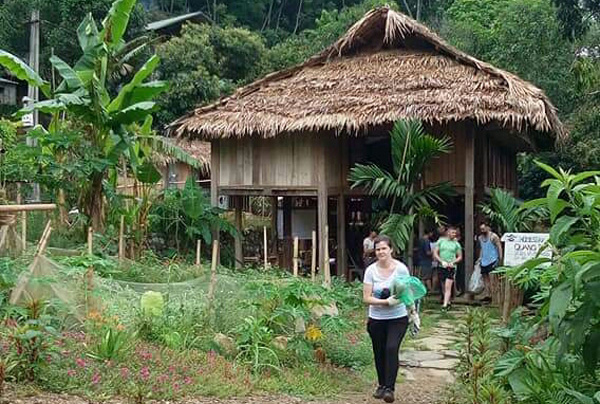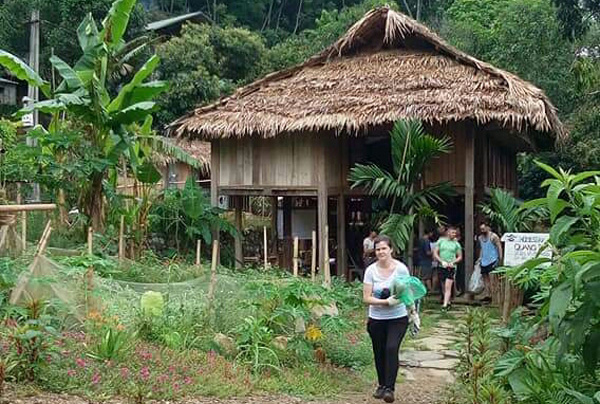
(HBO) - "The romantic landscapes of clouds and water is so poetic, charming, unique cultural identity, true emotion of the people living in the area of Hoa Binh Lake is a good choice for tourists in the country and abroad. The number of visitors from European countries coming to learn, experience the culture and nature of community tourism destinations, such as Sung village, Cao Son commune; Ke village, Hien Luong commune; Da Bia village, Tien Phong commune; Da Bac district has increased significantly"- the Director of Da Bac Tourism joint Stock Company Dinh Thi Thao announced.

The international visitors are visiting Da
Bia village, Tien Phong commune (Da Bac).
Da Bia village, Tien Phong commune is located
near the edge of Da River lake, there are dozens of Muong ethnic households
living. The cultural space and landscapes here, which is still almost original,
become the new and attractive destination for international tourists. Ms. Bui
Thi Nhem, the owner of Ngoc Nhem homestay said delightedly: the international
tourists mainly come from Europe. Almost every week there are international
visitors coming to the village. They go in groups of about ten or more, staying
overnight. They love to learn the cultural identity and the life of the local
people. The local people guide them on trekking to explore the jungle, rowing
at the bay, swimming and fishing on Da River. International guests do not
demand for the quality of service, they prefer the most of cultural identity of
walking, climbing, riding or exploring the jungle. Together with local people,
they harvest rice, fish, hunt, weave, knit; participate in the art performance,
bamboo pole dance, drinking Can wine with the local people", etc. Most
visitors have good feeling when visiting Da Bia village. The stilt houses, the
rhythm of bamboo pole dancing leave a good impression for international guests.
Homestay doers have learned English to communicate with international tourists.
At first, they can contact with common sentences such as introduction of the
village, home, asking about health and work, etc.
The activity of community-based tourism has
contributed to improving the lives of the villagers. Da Bia village has 40
households with 183 people, most of who have participated in community tourism.
At present, Da Bia has 4 community guest houses of Dinh Thu, Quang Tho, Ngoc
Nhem and Lakevie. The natural scenery and living habits of the villagers have
made good impressions to international visitors.
Up to now, Da Bac district has had nine
homestays, which are running business of welcoming visitors and in the first 6
months of 2018, the community tourism of Da Bac district has welcomed over
2,000 international visitors.
Located just a 20-minute drive from Hoa Binh City, Ora Hill Farmstay & Glamping Hoa Binh is a captivating new destination nestled in Mo hamlet, Bình Thanh commune, Cao Phong district. Combining farming with leisure, this tranquil retreat is perfect for those seeking balance, joy, and an immersive experience in the expansive beauty of nature.
Muong Bi - Tan Lac is renowned as one of the four famous Muong regions in Hoa Binh province. Blessed by nature with a favourable climate and stunning landscapes, Tan Lac holds great advantages for tourism development. The local tourism industry has made remarkable strides in recent times thanks to the attention and support from the local authorities and sectors.
With its strategic location, well-developed transport network, and diverse soil and climatic conditions, Hoa Binh is emerging as a must-visit destination in Vietnam's northwestern tourism corridor. The province boasts numerous attractions, including the Kim Boi hot springs (Kim Boi district), the Dau Rong cave complex (Cao Phong), the Mai Chau valley (Mai Chau), and the iconic Hoa Binh hydropower plant.
The northern mountainous province of Hoa Binh has been listed among the 71 most beautiful places to visit worldwide by the prestigious US travel magazine Condé Nast Traveller.
Hoa Binh province’s rich natural and cultural resources position it as a prime location for developing community-based tourism (CBT). In recent years, support from central and provincial policies, as well as assistance from non-governmental organisations, have encouraged local ethnic minority and mountainous communities to actively engage in the sector.



